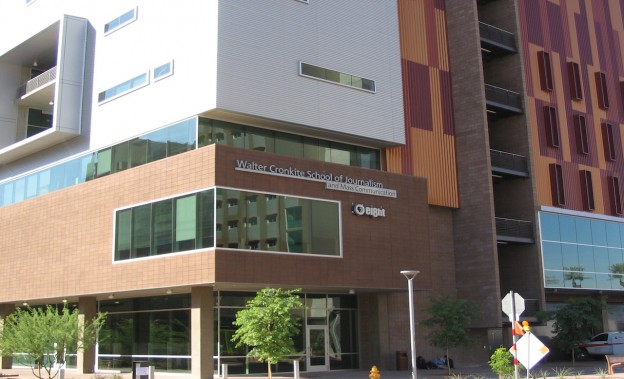Arizona State University’s Walter Cronkite School of Journalism and Mass Communication is partnering with American Public Media on a new startup called the PIN Bureau. Students in the bureau help newsroom clients across the country engage with their communities and develop enterprise stories through use of APM’s Public Insight Network.
In a PIN Bureau pilot this semester, Cronkite students worked with the staff at APM and more than a dozen print, radio and television newsrooms from small, mid-size and large markets. They queried thousands of sources on topics ranging from economic inequality to experiences buying mattresses. They learned how to manage client relationships and pitch story ideas.
But another goal of the PIN Bureau is to develop a sustainable business model for journalistic collaboration. The project is funded by a three-year grant from the John S. and James L. Knight Foundation, with additional support from the Corporation for Public Broadcasting and APM. After year three, the bureau is on its own. That means, in addition to learning about tools for engagement and collaboration, Cronkite students are learning how to launch a business.
Following a lean startup model, students are crafting a plan for the future. They are developing services to provide. They are interviewing journalists to test assumptions. They are experimenting with workflows and project management tools, and they are defining a mission and vision for the bureau.

Cronkite student Brooke Stobbe analyzes submissions within the Public Insight Network platform. Credit: Water Cronkite School of Journalism and Mass Communication.
At the end of the semester, I asked the students to write about what they learned and what guidance they would offer other students. Here are five strategies we found helpful and some of the observations the students shared.
Put Students on the Front Lines
From the beginning, students in the PIN Bureau have engaged directly with sources and journalists. Journalists in client newsrooms fill out an online form to request services, and students follow up to clarify assignments before digging into new projects. Students have developed professional communication skills and gained a better understanding of how journalists operate.
“I’ve also learned that they’re much more casual than I thought,” said sophomore Brooke Stobbe. “Being a professional isn’t about looking the part or sounding smart. It’s about asking the right questions, even when you don’t have any.”
Share Reflections
At the end of each week, the students and I used a Google document to post reflections, including our biggest frustrations. These ranged from technical glitches and miscommunications to resistance from potential clients.
These frustrations drove innovation. We began each subsequent week by brainstorming ways to address concerns, and then we implemented solutions. Over time, the students began to integrate the process into their daily routines.
“Don’t expect perfection immediately,” said senior DiAngelea Millar. “Continue the conversations in order to find answers to your problems.”

Cronkite students Dominick DiFurio, Brooke Stobbe and DiAngelea Millar meet with PIN Bureau chief Rebecca Blatt. Credit: Walter Cronkite School of Journalism and Mass Communication.
Ask Big Questions, One at a Time
We started with a lot of big questions: What services would we provide? What value could we offer? What might newsrooms be willing to pay?
We knew our answers to these questions would evolve, and each time we made headway on one, we had to adjust our thinking on the others. But as much as possible, we tried to approach these big unknowns one at a time.
Students learned as much as they could about using the PIN platform. They identified what worked and what didn’t. They approached a variety of journalists to gauge interest. They reassessed whether we were on the right track.
Each time through the cycle, the students grew more confident and more comfortable.
“The biggest takeaway from this experience – I’ve realized startups aren’t such impossibly monstrous things to take part in,” said junior Dominick DiFurio.

Cronkite student Brooke Stobbe revises the PIN Bureau workflow. Credit: Walter Cronkite School of Journalism and Mass Communication
Interview Current and Prospective Clients
Once students began to master the PIN platform and develop meaningful relationships with journalists, they began interviewing current and prospective clients. They asked questions about communication, existing community-engagement efforts and a willingness to outsource.
“I’ve learned this semester that the company is more about (addressing) a pre-existing problem, and you will be successful if your program is making that problem go away or be more manageable,” Stobbe said.
Speaking with clients who valued our services inspired the students to keep going, but interviewing journalists who were not open to working with the PIN Bureau clearly discouraged them. In those moments, we discussed the importance of honest feedback and fine-tuning our pitch.
It was hard for me to watch, and probably harder for them to endure, but it ultimately allowed them to build the resilience they need to move forward.
Invite Guest Speakers
Over the course of the semester, we invited guests to speak about cybersecurity, the lean startup model, community and ethnic media, and investigative reporting. I knew each guest would share valuable insights, but I did not anticipate that the process of inviting outside speakers would send a powerful message about asking for help.
“Reflect on those areas where you might not excel, and be humble enough to admit to them,” DiFurio said. “And then pull in other people to either teach or perform those functions for you.”
Lessons of humility, courage and a willingness to take risks prepared us all for the challenges to come.
Rebecca Blatt is PIN Bureau Chief and Professor of Practice at Arizona State University’s Walter Cronkite School of Journalism and Mass Communication. Before moving to Phoenix, she spent eight years in public radio at WAMU, NPR and WUNC. You can follow her on Twitter @reblatt.

